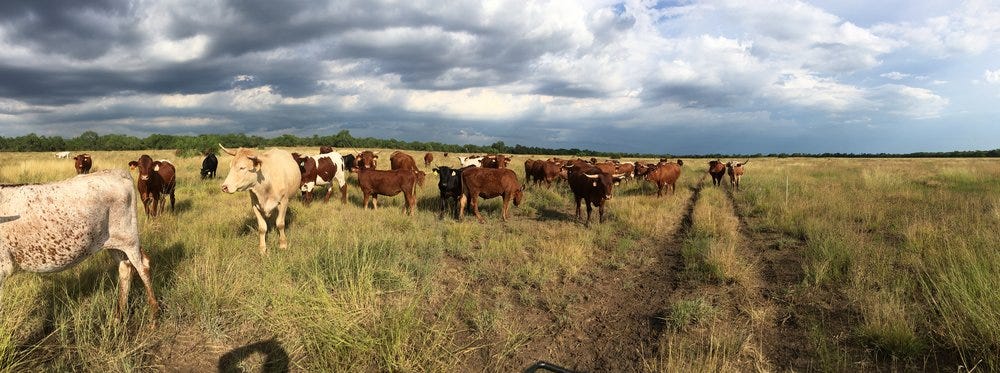🐄 Going beyond carbon: Assessing the latest White Oaks Pastures report
Progress: As we prepare for a future where the global appetite for meat is expected to double by 2050, ranchers must juggle the responsibility of producing nutritious meat while also maintaining and rebuilding the health of ecosystems. In recent years, press reports have questioned the validity of farmers touting “carbon neutral meat” in the wake of a regenerative agriculture resurgence. These criticisms were temporarily stymied in 2019 when Quantis published a promising life cycle assessment (LCA) of White Oaks Pastures (WOP), which utilizes holistically managed grazing systems across 3,200-acres. The initial study asserted that WOP, a well-known regenerative farm in Georgia, offset “at least 100 percent of [its] grass-fed beef carbon emissions.” And in November of 2020, a group of scientists came together to publish a peer-reviewed LCA on the original research done at WOP - reaffirming that compared to certified animal feed operations (CAFOs), multi-species pasture rotations (MSPRs):
Sequester more carbon into the soil: WOP regenerative grazing practices helped to draw down 2.29 megagrams (Mg) of carbon per hectare annually. For context, sequestering one Mg of carbon per hectare each year on 50 percent of California’s rangeland would offset 42 million metric tons of CO2.
Reduce greenhouse gas (GHG) emissions: Over the past few decades, WOP has managed to reduce its grazing system’s net GHG emissions by 80 percent. The result was a carbon footprint 66 percent lower than conventional commodity beef production. This finding confirms that we can thoughtfully redesign modern livestock systems to utilize ruminant animals' ability to act as biological up cyclers.
In short, none of the study’s eight co-authors deny the improvements demonstrated by MSPRs across soil health characteristics. The one catch is that the regenerative grazing benefits required 2.5 times more land to achieve. And when thinking about food production through a narrow lens of feeding a growing population, this detail presents land-use tradeoffs associated with grass-based pasture systems. But if the goal is to maximize nutrient production, then improving degraded soil is crucial for future food production.
Critics of the revised LCA are also quick to point out that the WOP grazing system emitted more carbon dioxide (CO2) than Beyond Meat’s plant-based protein alternative, which still emitted 3.4 kilograms of C02 per patty. Even though Beyond Meat touts a slightly lower carbon footprint, the question still remains: What are industrially manufactured meat alternatives contributing to restore degraded farmland and chart the US on track for a more resilient food system? When you hold up a microscope to most meat proxies, you may be shocked to find products assembled with the help of industrial supply chains, chemical inputs, and genetically modified crops. Beyond carbon, regenerative grazing comes with a host of benefits - including a vast increase in organic soil matter, which serves as a reservoir of nutrients and water into the ground. Increases in soil matter generated increases in microbial activity, water infiltration, and protection against soil compaction.
Instead of dismissing the potential of regenerative livestock systems because of land-use tradeoffs, we must put the research into context. The ability to transform marginal grassland - that is not suitable for crops for human consumption - into areas for high-quality protein production, in addition to land-based carbon sinks, is an exciting opportunity for agriculture. Rather than replacing all grasslands with pastures, why not incorporate silvopasture systems, which is the deliberate integration of trees and grazing animals on the same land in a way that adds value to the ecosystem? Policymakers and land stewards must consider these natural approaches that build climate resilience while also reducing the GHG footprint of beef production.
Listen: In this episode of the Broken Brain Podcast, Dhru Purohit sits down with Carey Gillam, an investigative journalist to discuss the hazards of glyphosate, a key ingredient in Roundup. In 2020, Bayer AG, the pharma and life sciences company that owns Monsanto, agreed to pay $10 billion to settle more than 9,000 class-action lawsuits to those who rightfully blamed its signature herbicide, Roundup, for their cancer diagnosis. Click the link to learn more about Monsanto’s efforts to promote glyphosate and what you can do to avoid pesticides in your diet.
Shop: Woolfolk yarns combine the highest quality wool with ethical, sustainable practices. The fiber they use, Ultimate Merino®, doesn’t happen by chance, but by the innovative efforts of farmers to produce the very best wool fiber while being land stewards of the Patagonian Grasslands. Woolfolk brings this soft and lustrous fiber in handknitting yarns that preserves the unique attributes of this luxurious wool. The company is kindly offering our audience a free pattern when they use the code "KNITWOOLFOLK" at checkout.
The Regeneration is brought to you by Wholesome Meats | Soilworks | PastureMap.




Great overview. Its beyond me how people would think fake meat is better than real meat!